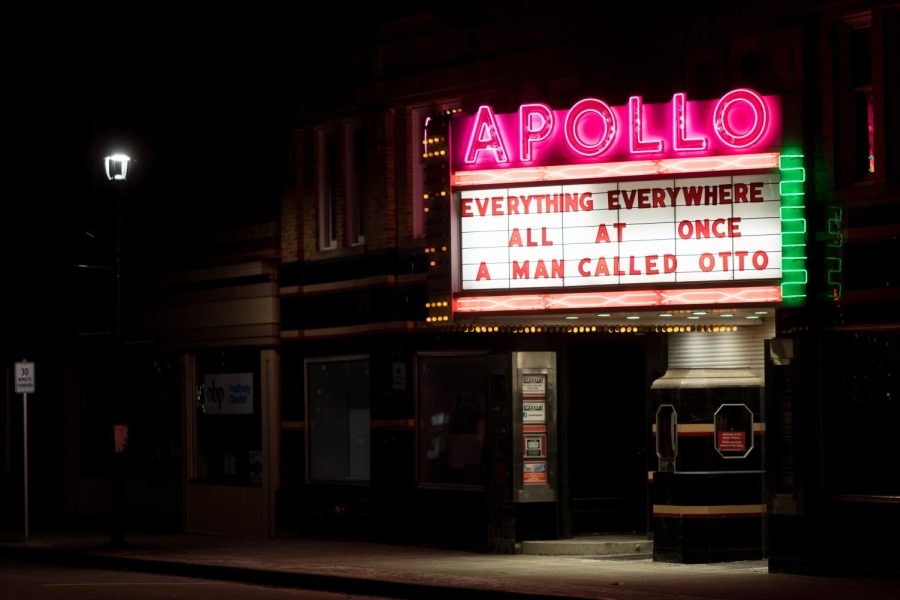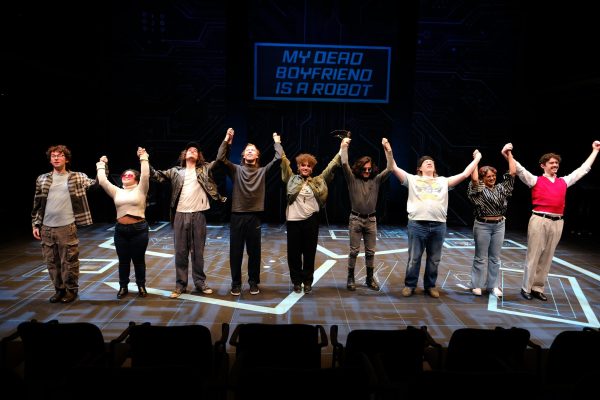Embrace Weirdness To Fully Enjoy Everything Everwhere All At Once
The Apollo Theater screened Everything Everywhere All At Once this weekend.
I first watched Everything Everywhere All At Once the night of the citywide power outage last October. Though the movie was released eight months prior, I had miraculously avoided nearly all spoilers and summaries, only hearing glowing reviews and something about rocks. Naturally, I came in with high expectations.
The beginning was easy to understand — a Chinese-American immigrant named Evelyn Wang (Michelle Yeoh) is struggling to save her audited laundromat and understand three family members: her annoyingly happy husband, Waymond (Ke Huy Quan), who is secretly seeking to file for divorce; her openly gay daughter, Joy (Stephanie Hsu); and her demanding father, Gong Gong (James Hong), visiting from China. As she goes to meet with an IRS agent, she is greeted by Alpha Waymond, her husband from an Alphaverse, who teaches her how to jump multiverses and save humanity from a villain named Jobu Tupaki, her omnicidal and interdimensional daughter created in the Alphaverse under stress and over-pressure.
After appearing as a promising action movie, the film transforms into… something. Epic fight scenes begin with people biting off a bar of chapstick or dry humping a pillar. There is a world where people have hot dogs for fingers, a moment when IRS inspector Deidre Beaubierdre (Jamie Lee Curtis) staples paper to her forehead, and another fight scene involving butt plugs. Jobu Tupaki is dressed in outlandish outfits fit for the Met Gala. As many have said, on paper, this sounds like a horrible idea for a movie.
Because of this, toward the 1.5-hour mark, I was starting to get tired, confused, and even angry. I couldn’t keep track of the many, many multiverses and was annoyed at constantly seeing the IRS building in scenes. Where were the emotions that people promised?
And then, there was the everything bagel.
The everything bagel is a black-hole-like entity of Jobu Tupaki’s creation, a weapon of mass destruction for herself, and the reason she tried to find Evelyn throughout the multiverses.
“I was just looking for someone who could see what I see, feel what I feel,” she explained to her mother.
As Evelyn comes to terms with what’s happening — that her daughter feels so hopeless she would build a black hole to end her life — Waymond offers epiphanies within different multiverses: one states that his optimism and positivity is a survival mechanism for himself; the other pleads with Evelyn to empathize with everyone. With that, she literally fights back with love and saves Jobu Tupaki from destroying herself with a hug, and the intense climax ends with mother and daughter in a parking lot sobbing in each other’s arms.
An hour after I finished watching, the power outage rolled across town. Left in the dark, it gave me a chance to reflect on what I had just watched, and my feelings of astonishment that a movie with a knockoff Ratatouille scene made me cry. I wondered, “Were those weird special effects really necessary?” Given that Michelle Yeoh, well-known for her roles in martial arts movies, was the main character, maybe the directors could’ve added some realistic adversity that Evelyn had to endure to prove the love she had for her family — add in a couple of tense scenes, and in the end, she could easily defeat the bad guys with a roundhouse kick.
But a couple months later, I watched the movie again, and that’s when I fully realized the role of these special effects. In one of the first action scenes, Alpha Waymond explains the philosophy of multiverse-jumping — the whole idea is to be out of the ordinary. EEAAO follows the same philosophy — it showcases the unknown and the unimaginable, our greatest fears beyond our families, jobs, taxes even. We don’t always think about what lies beyond us in the solar system or what would happen if we just chose a different career path or first love to run away with. The movie doesn’t offer that luxury and forces Evelyn to confront her failures, rejections, and what-ifs as she searches for her daughter.
Through the madness, meaning can be found in life and relationships. We learn that there is no law of physics, no artistic masterpiece, no alternate life that could come between the love Evelyn has for her daughter. She will chase Animal Control while manipulating a man’s head, tumble down a steep cliffside as a rock with googly eyes, or destabilize opponents with her super strong pinky fingers to prove it. Although she may not always understand everything about Joy, such as her sexuality, she will do everything in her power to make an effort to understand, to forgive, to heal.
In its purest form, EEAAO is a story of resilience and love. Through its quirks and oddness, it lets the viewer sit with their discomfort, fears, and anxieties about life and teaches that, in the end, nothing really matters. However, that can be a good thing if we’re with the people who continuously work to find kindness and joy in emptiness.
“Maybe there is something out there, some new discovery that will make us feel like even smaller pieces of shit,” Evelyn says toward the end of the movie. “Something that explains why you still went looking for me through all of this noise. And why, no matter what, I still want to be here with you. I will always, always, want to be here with you.”
Here’s to hoping we all find that person who will bring us out of darkness.








